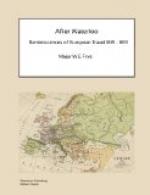In the environs of Turin, the most remarkable buildings are a villa belonging to the King called La Venezia, and the Superga, a magnificent church built on an eminence, five miles distant from Turin. In the Royal Palace, on the Piazza del Castello, there is some superb furniture, but the exterior is simple enough. The country environing Turin forms a plain with gentle undulations, increasing in elevation towards the Alps, which are forty miles distant, and is so stocked with villas, gardens and orchards as to form a very agreeable landscape. From the steeple of the Superga the view is very fine.
In the University of Turin is a very good Cabinet d’Histoire naturelle, containing a great variety of beasts, birds and fishes stuffed and preserved; there is also a Cabinet of Comparative Anatomy, and various imitations in wax of anatomical dissections. Among the antiquities, of which there is a most valuable collection, are two very remarkable ones: the one a beautiful bronze shield, found in the Po, called the shield of Marius; it represents, in figures in bas-relief, the history of the Jugurthine war.[76] This shield is of the most exquisite workmanship. The other is a table of the most beautiful black marble incrusted and inlaid with figures and hieroglyphics of silver. It is called the Table of Isis, was brought from Egypt and is supposed to be of the most remote antiquity. It is always kept polished. Among the many valuable pieces of sculpture to be met with here is a most lovely Cupid in Parian marble. He is represented sleeping on a lion’s skin. It is the most beautiful piece of sculpture I have ever seen next to the Apollo Belvedere and the Venus dei Medici; it appears alive, and as if the least noise would awake it.[77]
Turin used to be in the olden time one of the most brilliant Courts and cities in Europe, and the most abounding in splendid equipages; now very few are to be seen. When Piedmont was torn from the domination of the House of Savoy and annexed to France, Turin, ceasing to be the capital of a Kingdom, necessarily decayed in splendor, nor did its being made the Chef lieu of a Prefecture of the French Empire make amends for what it once was. The Restoration arrived, but has not been able to reanimate it; an air of dullness pervades the whole city. Obscurantism and anti-liberal ideas are the order of the day.
I witnessed a military review at which the King of Sardinia assisted. The troops made a very brilliant appearance and manoeuvred well. His Majesty has a very good seat on horseback and a distinguished military air. He is a man of honor tho’ he has rather too high notions of the royal dignity and authority, and is too much of a bigot in religion; but his word can be depended on, a great point in a King; there are so many of them that break theirs and falsify all their promises. He will not hear of a constitution, and endeavors to abolish or discountenance all that has been effected during his absence. The priests are caressed and restored to their privileges, so that the inhabitants of Piedmont are exposed to a double despotism, a military and a sacerdotal one; the last is ten times more ruinous and fatal to liberty and improvement than the former.




